For much of Scotland’s prehistory and early history the basic dwelling
was the round house. This simple but effective domestic unit is known
across the world. At its centre a hearth supplies practical facilities
for cooking and warmth. As importantly, it provides a social focus for
its occupants, who can sit communally around the fire. Beyond this space
the structure requires one or more circles of poles or pillars, and these
form divisions around the edge of the house which can be utilised for
various purposes - living space for groups or individuals, or areas for
specialised activity. Modern examples of round houses demonstrate complex
patterns of social relationships, gender, status, and behaviour, often
underpinned by concepts of ritual and spiritual belief. Similar patterns
probably existed in the Iron Age.
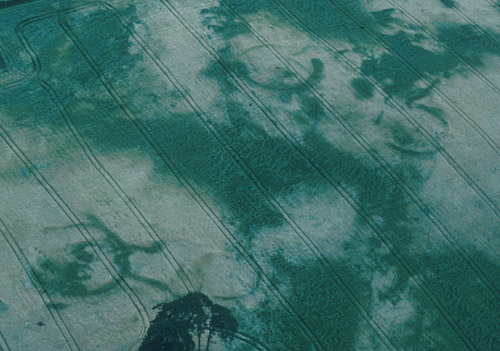
Aerial photograph showing evidence of timber round houses
(revealed by crop-marks of their circular foundation trenches) at Coin
Hill, Perthshire.
©
Colin Martin
Such houses could be made of wood or
stone, depending on which material was most readily available. Thus the
largely treeless Northern Isles developed a tradition of stone-built houses.
Some have interior partitions arranged like the spokes of a wheel, and
are called ‘wheel houses’. In lowland areas, where timber
predominated, houses were usually built of wood. They almost never survive
in visible form, and it used to be thought that there had been little
or no settlement in these zones. However the post-holes and slots cut
into the subsoil to hold the timbers often show up as crop-marks, and
so in recent years the lowlands have been extensively ‘repopulated’
with prehistoric settlements.
The roofs were of turf or thatch, set on timber frameworks. Houses of this kind varied in size, but were often 20 metres or more in diameter. The larger ones could have held as many as 30 people, suggesting that they housed extended kinship groups rather than nuclear families.
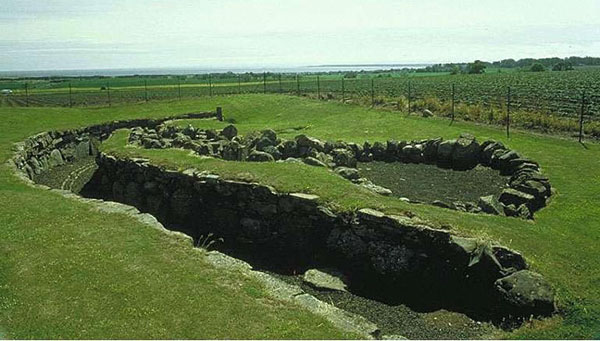
An excavated souterrain at Ardestie,
near Dundee.
© SCRAN/Historic Scotland
Souterrains are underground chambers often associated with round houses.
They predominate along the eastern coastlands, mainly beyond the Tay,
and in the Northern and Western Isles. Their purpose is not absolutely
certain, but most probably they were used to store food, perhaps mainly
grain. Many seem to have a capacity much greater than would be required
by the house to which they were attached, which suggests that its inhabitants
were responsible for supplying food to others. This in turn implies a
level of power and control over their neighbours. Souterrains seem mainly
to date between the first century BC and the first or second centuries
AD. Roman objects have been found in some of them.
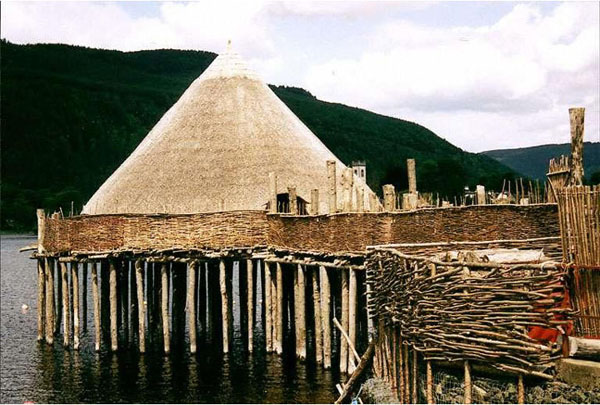
A reconstructed Iron Age crannog in Loch
Tay.
© SCRAN/Private Collection, via NMS Multimedia Team
A variation on the round house is the crannog, set on poles in lochs or shallow estuarine waters. As these timbers rotted they were replaced with new ones, and reinforced with stones, so surviving crannogs today often appear as submerged or nearly submerged mounds. Many date to the Iron Age. Because of their waterlogged nature much organic material and environmental evidence can survive in these mounds, and so they are a rich source of information about ancient material cultures and economies.
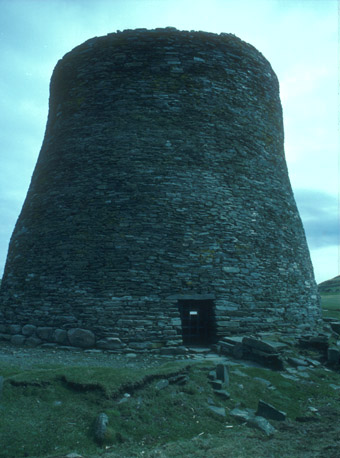
The broch at Mousa, in Shetland.
© Colin Martin
A sophisticated and impressive variation of the stone-built roundhouse
is seen in the brochs of the west and north. Most appear to date to the
last two centuries BC and the first century AD. Brochs are circular towers
built of inner and outer dry-stone walls held together by cross-slabs
locked by the weight of the structure. Interior chambers and stairs were
contained between the walls. Within the broch a wooden structure appears
to have held one or more upper floors and a roof. There were no external
openings in the walls except for a single entrance which could be securely
barred. The most complete example is on the island of Mousa in Shetland,
which still stands over 13 metres high. Most brochs were not so tall.
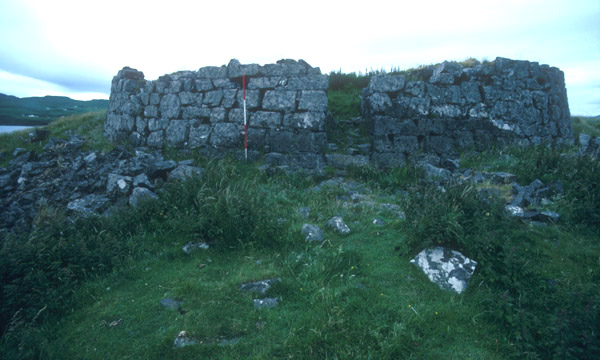
Remains of a dun at Ardtreck, on Skye.
A number of Roman objects have been found at this site.
© Colin Martin
Duns were built in a similar way, but were less complex and often lack stairways, suggesting that they may have been only one storey high. They predominate in Galloway and the western Highlands and Islands, and in parts of Central Scotland.
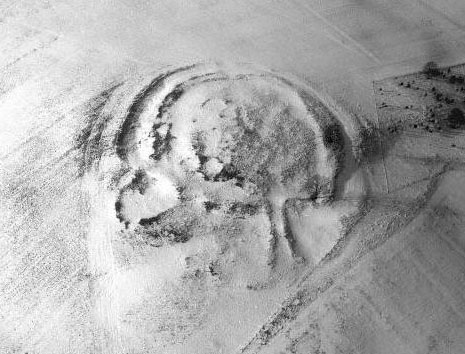
Aerial view of the hillfort at Muirburn,
Borders. Hut circles can be discerned inside the rampart, but later
settlement overlies the defences.
© SCRAN/RCAHMS
A final category is the hillfort, examples of which are found in many
parts of Scotland although the largest of them, and the greatest number,
cluster in the south east. Like all prehistoric monuments, the name and
the criteria we apply to them are modern constructs. Hillforts range from
small enclosed settlements to enormous fortified enclosures. The few that
have been excavated indicate long and complex histories, going back in
some cases to the beginning of the first millennium BC. Their fortifications,
moreover, often seem to reflect occasional and sometimes short-lived episodes,
with later hut circles frequently impinging upon or even overlying earlier
defences.
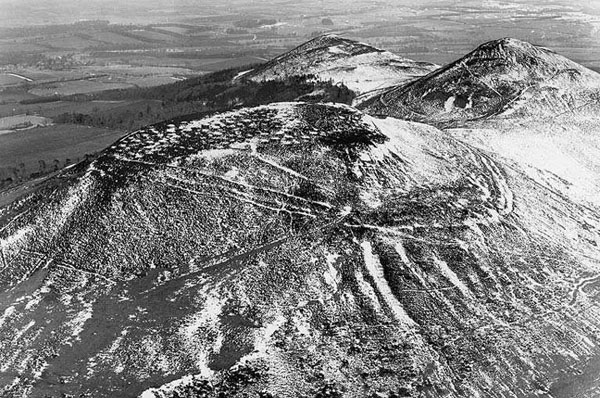
Eildon Hill North
© SCRAN/Historic Scotland
The largest hillfort in Scotland is Eildon
Hill North, which is believed to have been occupied from c.1000 - 600
BC, and possibly into the Roman period. This 16-hectare enclosure may
have contained as many as 300 hut circles, implying a population (if they
were all occupied at the same time) of up to 5000 people. They are unlikely
to have lived there permanently, however, since the hilltop has no adequate
water supply and it is an inconvenient distance from the farms which its
inhabitants must have cultivated on the lower ground. More probably it
was a place for occasional tribal gatherings and, if so, a considerable
level of social cohesion and political authority is implied.
The architectural traditions and settlement characteristics of Iron Age Scotland make the situation which faced the Romans tolerably clear. There was a moderately unsettled zone in the south which could be contained by a network of roads and garrisons. These, additionally, would provide the lines of communications needed to support operations further north. The settled farming tribes of East Lothian, and perhaps Fife, could be left largely to their own devices, perhaps under some kind of treaty accord with Rome. If necessary, the Forth-Clyde isthmus which effectively divided Scotland into two islands could be controlled by a chain of garrisons. Beyond lay the eastern coastlands with their patchworks of open settlements. This area was evidently the seat of considerable power and political cohesion, based on its extensively farmed soils. Events would show that it was implacably hostile to Rome.
There remained the Highlands, and the Northern and Western Isles. Rome probably never had any intention of penetrating these areas. The brochs and their ilk speak of power and social cohesion on a local scale, but the fragmented and small-scale nature of settlement in a harsh environment militated against the larger-scale political development which could pose a military threat. Rome’s best response to these regions was probably to bottle them up.